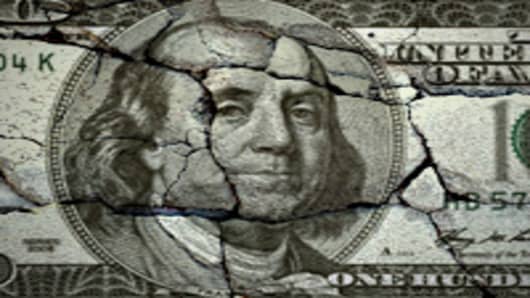The weak-dollar trade, which has been at the heart of an 18-month rally across virtually all asset classes, could be coming to an end soon—posing new risks for investors.
Stocks, commodities, bonds and other assets have all benefited as policy makers kept the US currency weakagainst its foreign competitors. And the Group of 20 meeting this past weekend—where officials agreed to shun competitive currency devaluations—seemed to clear the way for the dollar to fall even further.
But there's a price to pay for all that devaluation. And some market pros think the dollar is reaching that point of diminishing returns, where the drop no longer has the desired effect and could soon start reversing itself.
"What you're seeing is simply a momentum wave against the dollar which doesn't have a lot of economic substance attached to it at all," says George Feiger, CEO of Contango Capital Advisors in San Francisco. "We are in this period of excess enthusiasm to sell dollars."
"It's certainly not something that's sustainable," Art Hogan, managing director at Jefferies, said in a CNBC interview (see video below). "You get to an inflection point where it's beneficial for our exports and multinationals, and then you lose that."
The danger most likely to garner investor attention is inflation. Soaring prices of high-demand items like oil and corn are driving prices higher for consumers and acting as a tax in a weak economy.
So as commodities keep surging higher, the pressure for a rising dollar likely will escalate.
"It's going to be a problem once we get north of $85 a barrel in crude. That's going to be a wake-up call for US consumers," says Dave Lutz, managing director of trading at Stifel Nicolaus in Baltimore. "At that point you're going to start seeing gasoline pumping up and that's going to be a tough tax on consumers that they can't deal with right now."
Nevertheless, the dollar has been hitting successive 15-year lows against the Japanese yen, and there's the temptation to ride the trade out for as long as the Federal Reserve is willing to keep printing money through its quantitative easing program.
The Fed's policy, commonly referred to as QE, is designed at getting money flowing by buying up Treasurys and other assets from financial institutions. The market is expecting the Fed to announce a second round of easing—QE2 in market parlance—at its November meeting.
But Lutz thinks it's time to get out of the cheap-dollar trade.
"We're starting to see a reversal in trend and we're going to start seeing the dollar rally," he says. "I think you lighten up on commodities and take some profits on the S&P and the industrials. If you want to continue to be exposed to equities, you probably want to roll into areas like technology, and we continue to see positive movement in health care."
Those with a shorter-term view—primarily traders—may want to keep playing the weak dollar for a while, however.
It could take until Nov. 2, when both the mid-term elections are held and the Fed next meets, until the sell-the-news aspect of the central bank's policies and the political upheaval take hold.
"At some point it will unwind. It's going to be buy-the-rumor, sell-the-fact once the Fed comes out with a quantitative easing number, unless the number is more than a trillion dollars," says Andre Julian, CFO and senior market strategist at OpVest Wealth Management in Irvine, Calif. "Until the Fed changes their tune and we keep printing money, we're going to see continued value from the weak dollar, which is going to help if you're on the long side of commodities."
Traders already are pulling back their bets against the dollar.
Last week's Commitments of Traders reports from the Commodities Futures Trading Commission showed a decrease in net short positions on the dollar from $29 billion to $25.8 billion, an 11 percent drop.
"You're probably going to get a pop before the end of the year in the dollar, anywhere from 5 to 10 percent," says Kathy Boyle, president of Chapin Hill Advisors in New York. "If the dollar starts to ride up, that implodes the gold trade."
The market has been backing off the weak-dollar trade in a succession of halting steps. Treasury Inflation Protected Securities have been near zero—a low yield suggests high demand for inflation protection—and consumers show expectations of 4.9 percent inflation, according to the latest Conference Board survey.
And investors continue to shun US equity funds, which have seen outflows for 24 consecutive weeks, according to TrimTabs market research. Global equity funds, contrarily, have seen inflows for seven straight weeks, including $1.5 billion in the past week, the highest total since April when stocks were around current levels.
"There isn't much substance to any of this. There's just waves of endless speculation," says Feiger, of Contango Advisors. "The realities are very boring and very sad. It will take years for this stuff to work it's way out."
Investors are left with deciding whether to play the short-term weaker dollar or the longer-term prospect of inflation and currency appreciation.
"Eventually the future will take care of itself. It's just a timing issue. While the rest of the world is looking at austerity, we're still looking at printing a lot of money," Julian says. "Even though you have a lot of scary things going on in this economy, you can still capitalize on that in the markets."




